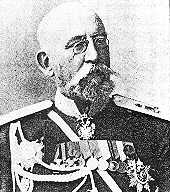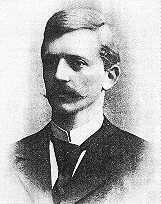THE MURDER
A 29-year Finnish civil servant shot
a 61-year-old Russian autocrat three times with a Browning pistol on the morning of June
16, 1904. He then proceeded to shoot himself twice in the heart. The Finnish clerk was
Eugen Schauman and the Russian tyrant was the governor general of the Grand Duchy of
Finland, Nikolaj Ivanovits Bobrikov. Schauman acted alone, there was no conspiracy. The
murder took place on the stairway in the Senate. This political murder turned out to be
one of those acts that changed history.
FINNISH REACTION TO THE DEATH OF
BOBRIKOV
Eugen Schauman died immediately, at
11 AM. Initially, the reaction of the
Finns was subdued; because it was unclear if Bobrikov would die. As the day wore on, the Finns began filling the
Helsingfors watering holes to “skåla” and congratulate each other. By evening, the celebrations became more jubilant,
and the police started to arrest those who appeared to be happy. Jean Sibelius, who later became a famous composer,
was arrested and hauled to jail, for what the police called “unmotivated
happiness” (omotiverad glädje). Restaurant
“Kapellet” which still serves patrons today on Esplanaden, sold champagne to an
increasingly merry crowd. The restaurant at Hotell Kämp was jammed with people who
eagerly listened to updates from the hospital about the situation. When the news of
Bobrikov’s death arrived then next day at 1 AM, the Finns met it with tremendous
exaltation and more arrests were made when they hit the street in a very celebratory mood.
| WHY DID THE FINNS HATE BOBRIKOV? In 1904 Finland was an autonomous Grand Duchy. The nation was
connected to the Russian empire only through the tsar who ruled both nations.
Finnish autonomy had been challenged already during the reign of tsar Alexander III and a
full scale merging of Finland into Russia was underway after Nicolas II became tsar. The
Finnish legislature was ignored and Russian laws were imposed on Finland. Russian was declared to be the official language
of the Senate, and Finnish military units were disbanded.
Finns were now conscripted into long military service with the Russian military.
The reaction of many of the potential conscripts was to avoid the Russian military service
at any cost and in order to do this, many of them emigrated to the USA. |
 |
The tsar Nicholas II’s chosen tool for assimilating Finland into Russia was
general Nikolaj Ivanovits Bobrikov. When he
was appointed to Governor -General of
Finland in 1898, his goal was to eliminate the Finnish army, Finnish money, and other
symbols of a nation such as the customs service. Finnish civil servants were to be
replaced by Russians. Freedom of assembly was curtailed. He also began a round up of
Finnish patriots who opposed his violations of the constitution by russifying Finland.
These patriots were sent to exile inside Russia. Many patriots managed to escape to
other countries, mainly Sweden. There was total censorship of the press. Many
editors who had voiced opposition to the illegalities were also forced into exile. One of
them, Eero Erkko, (who later owned Helsingin Sanomat, now the leading daily in Finland)
left Finland and lived a few years in the United States.
| EUGEN SCHAUMAN. Eugen Schauman
was a nobleman. A Swedish king had knighted
the patriarch of the Schauman family in the late 1600’s. The family had a military
tradition, which carried all the way to Eugen Schauman’s father, who eventually
became a general. Eugen was born in the
city of Harkov in Ukraine where his farther was a military official. The father was then
transferred to Poland when Eugen was young. The
first time Eugen was to become a permanent resident in Finland was at the age of 9 when he
started school in Helsingfors. While the rest of the family continued to live in Poland,
young Eugen was lodged with family members, so he could attend Nya Svenska Läroverket in
Helsingfors, a private school that is nicknamed “Lärkan”. Unfortunately, Eugen
was a poor student throughout his time in school. He suffered from an incurable hearing
condition, which made his time at Lärkan very difficult. By living in Slavic countries,
he had also acquired a Slavic accent that exposed him to ridicule. He did finish, and upon
graduating from Lärkan, Eugen studied government at the University in Helsingfors.
Eventually, Eugen became a clerk in the Senate. |
 |
Eugen was an outdoorsman and a sportsman. He was an avid hunter who traveled long
distances to hunt. He extended his hunting trips quite far from Helsingfors, all the way
to Vestankvarn in Ingå where he hunted grouse. He also joined a nation wide hunter’s
organization named “Finlands Jaktförening”, and became eventually the treasurer
for that organization. With the Russification efforts, it was clear to Eugen that the
Russians would not leave Finland unless they were forced to do so as a losing side in a
revolution. Eugen wanted to use the hunter’s organization as a means to train the
youth in the use of rifles. He even went so far as to import U.S. made Winchester 25-32
rifles, which he sold hoping to produce a militia skilled in marksmanship. He eventually
realized that the Winchester was too small for military use and later promoted the Mauser
rifle.
THE PLOT THICKENS
So far we have presented the
oppressor, the hero and the motives for the murder. Now we must explain why Eugen
committed suicide. Elin Borgström was the GREAT LOVE in Eugen
Schauman’s short life. Eugen apparently met Elin Borgström around 1892. Elin was 3
years younger then Eugen, but she had a brother who was Eugen’s hunting partner. Eugen and Elin skated and cross-country skied
together and also played a brand new sport just in from England called lawn tennis. The Borgström family is of the landed gentry and
they still own the estate in Sibbo named Östersundom Gård.
Eugen fell in love with Elin and began to plan their future together. At one time, he even
planned to immigrate with Elin to Canada. Unfortunately, Eugen’s love for Elin was
not returned. Eugen and Elin were very good friends and Elin certainly had a lot of
respect for Eugen. She was eyewitness of an incident where Eugen knifed a Russian mounted
Cossack militia who hit him in the head with his riding whip. This happened April
18’th 1902. Eugen was on his way home
from work, and the attack was unprovoked. Eugen
immediately pulled out his Finnish “puukko”
(similar to a small Bowie) knife and hit the Cossack with it in the chest. The
Cossack falls off his horse. He was not hurt even that Eugen hit him so hard that the
knife bent. Eugen escapes to a nearby doorway. (Helsingfors
must have been a tough neighborhood at that time when even the civil servants carried
puukko knives to work.)
Elin Borgström apparently was one
lady who young men could easily become in love with. At least three men competed
simultaneously for her hand in marriage. When Eugen proposed to Elin on Oct. 24’
1903, she responded with the word “aldrig”, Swedish word for “never”.
After that date, everything pointed to Eugen planning to kill himself after shooting
Bobrikov. Eugen arranged with a friend to send flowers to Elin on her next three
birthdays. He had written the cards and envelopes that were to be attached to the flowers.
The first two cards were addressed to Elin Borgström. The third card was addressed to
Elin Florin. Eugen’s prediction that Elin would marry Einar Florin was accurate, but
when the flowers arrived, she was still Miss Borgström. They married four months later.
The Russians originally paced
Schauman's body in an unmarked grave. After Russian opposition to a marker had subsided,
Finnish college students collected funds for an impressive monument for Schauman's grave in Borgå.
HOW DID EUGEN SCHAUMAN CHANGE
HISTORY?
The Russification of Finland was temporarily slowed because the new governor
general was much less aggressive. The Russians also got second thoughts of the wisdom to
take Finnish conscripts to the Russian military. The Russians realized, that training
Finns in military skills would be like training a guerilla which eventually could be
turning against the Russians. The conscription of Finnish men to the Russian army ended
the following year. The elimination of the conscription saved thousands of Finnish lives
in WW I, because the only Finns involved in that destructive war were volunteers.
The murder of the hated Bobrikov gave the Finns courage. The Finns stiffened their
opposition to russification. An “activist” movement was strengthened. A
nation that had suffered oppression now had confidence. The steps toward independence did,
in fact, closely mirror Schauman’s plans. Military
training took place in secrecy, just as Eugen had planned, not only in hunting clubs, but
also under the guise of fire companies and gymnastic clubs.
NATIONAL HERO OR TERRORIST?
At the 100’th anniversary of the
murder of Bobrikov, the Prime Minister of Finland, Matti Vanhanen, showed his ignorance of
history by declaring Schauman’s act as terrorism.
. There are similar connections in
world history where the assassins, even when part of a conspiracy, are looked upon as
heroes. One such assassination attempt was
made on Hitler by colonel von Stauffenberg on July
20, 1944. The German Prime Minister placed flowers on von Stauffenberg’s grave on the
attempt’s 60’th anniversary. He apparently is not as illiterate of history as
his Finnish counterpart. Famous Finnish patriots such as the former president
Svinhufvud have a different view of Schauman. He said; ”The people of Finland blesses
his memory. It acknowledges that by sacrificing himself, Schauman freed his country of an
oppressor.”
Author:
Rainer Langstedt Spencer, New York
Email: langstedt@htva.net

